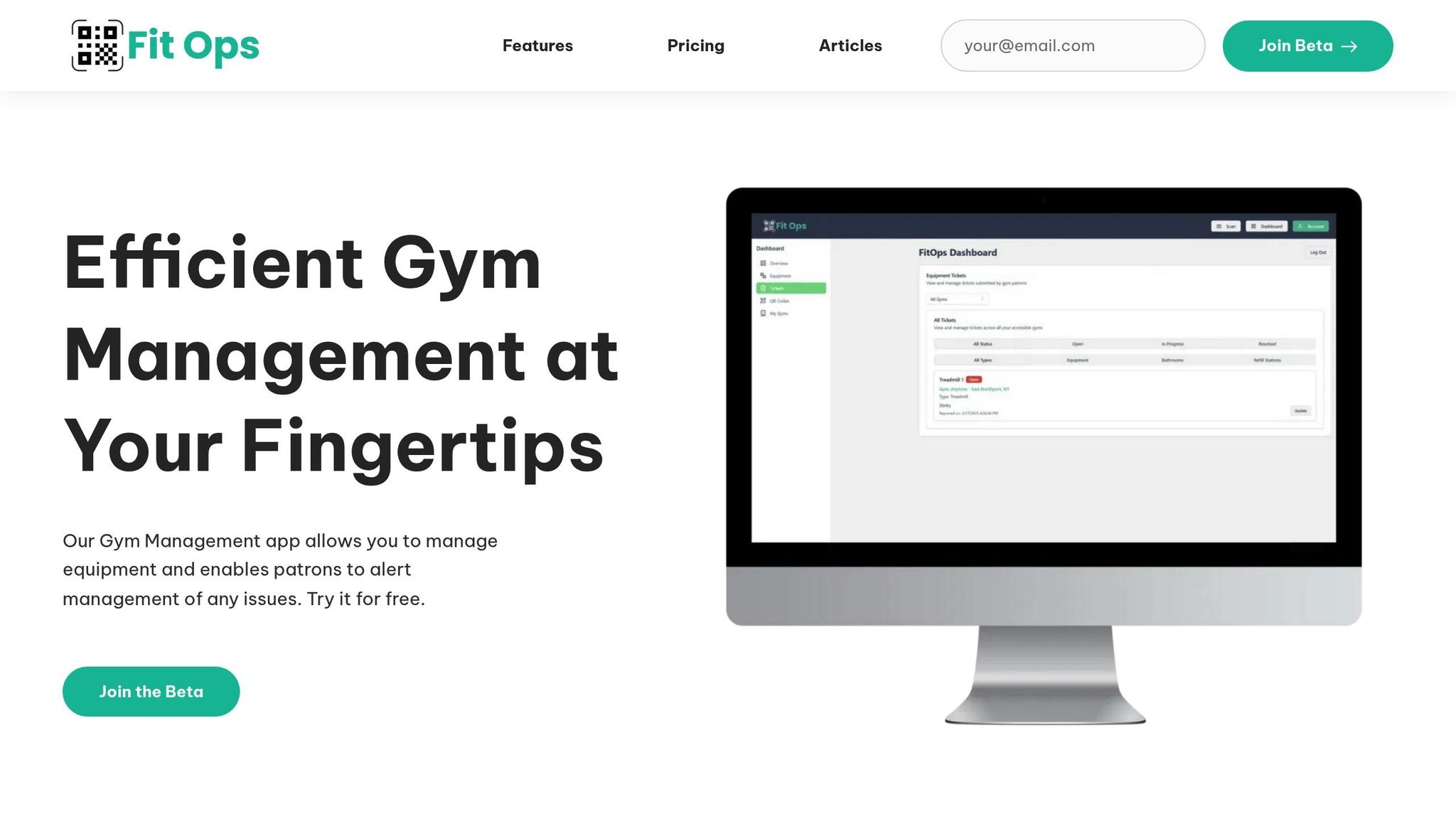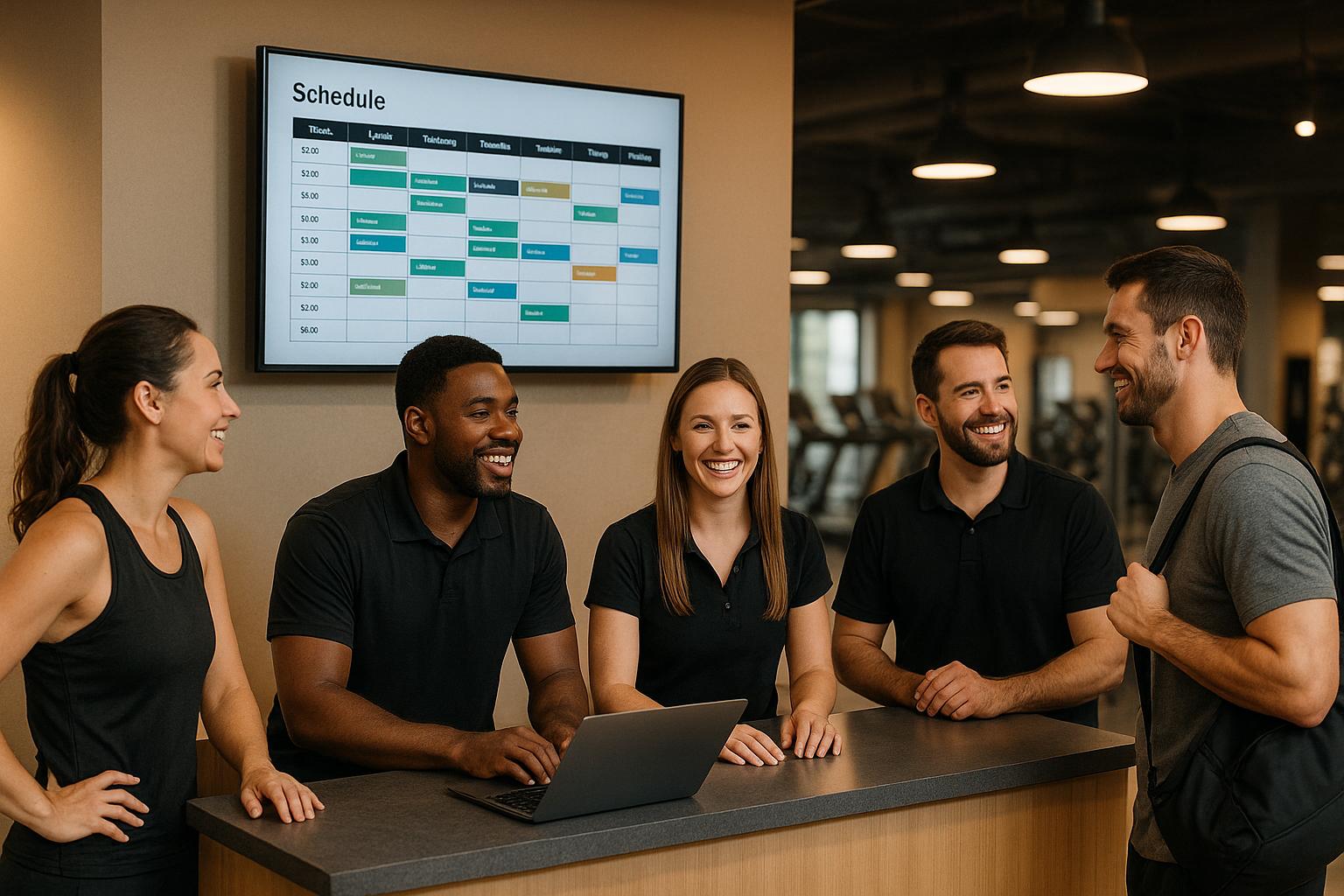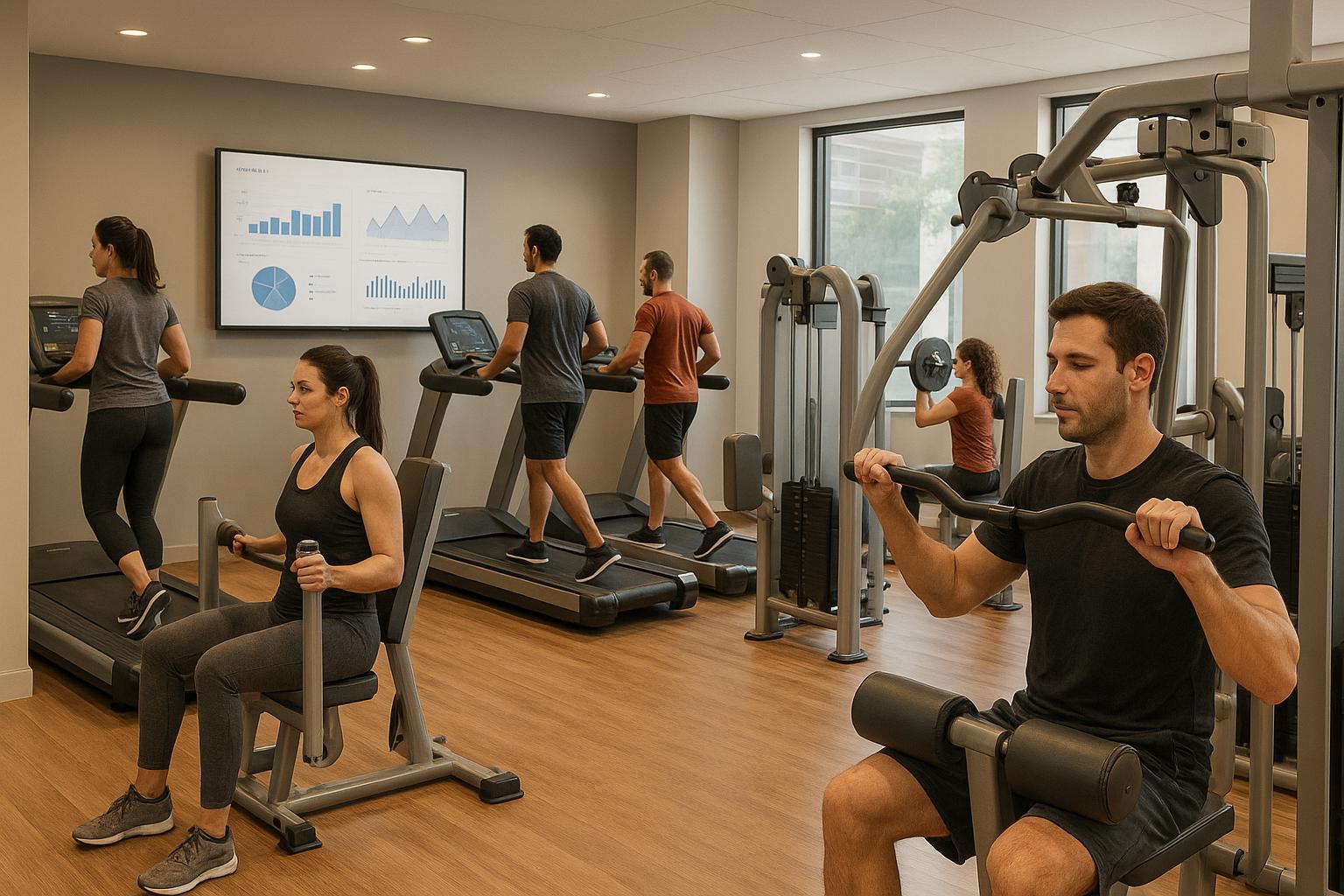Effective gym team collaboration is about clear communication, task management, and building a strong team culture. Here's what you need to know:
- Communication Tools: Use centralized platforms for real-time updates, shift schedules, and task coordination. Instant messaging works for urgent issues, while scheduled updates handle non-urgent matters.
- Task Management: Digital tools simplify scheduling, assign responsibilities, and track progress. Features like mobile access and recurring tasks help streamline operations.
- Feedback and Recognition: Regular feedback sessions, anonymous surveys, and recognition programs improve morale and teamwork.
- Training and Process Reviews: Ongoing training and monthly workflow reviews keep teams aligned and efficient.
Example Solution: Fit Ops Gym Management Software integrates communication, task management, and issue reporting into a single platform. At $39/month per location, it enables unlimited team access and features like QR code equipment tracking and mobile-friendly interfaces.
Takeaway: Combining clear communication, structured workflows, and the right tools ensures smoother operations, happier staff, and better member experiences.
6 Tips For Effective Teamwork
Setting Up Clear Communication Channels
Streamlining communication is key to keeping everyone on the same page. By using a single platform to centralize team updates, staff can easily access schedules, announcements, and task assignments. This reduces confusion and helps everyone respond quickly when needed.
Central Communication Platforms
Centralized messaging systems are a game-changer for keeping work updates organized and easy to find. Managers can send real-time updates about equipment issues, schedule changes, or safety protocols directly to staff devices, ensuring no one misses critical information.
Shared calendars simplify shift scheduling and task coordination. Staff can quickly check upcoming shifts, maintenance timelines, or special events, making it easier to manage room availability and responsibilities without guesswork.
Group notifications are perfect for delivering important updates to everyone at once. Whether it’s a policy change, a reminder about an upcoming staff meeting, or an alert about equipment affecting member safety, these notifications ensure everyone is informed simultaneously.
When all these features are integrated into one platform, communication across departments - whether it’s the front desk, trainers, or maintenance crew - becomes seamless. To maximize efficiency, it’s also important to distinguish between urgent alerts and updates that can be scheduled for later.
Real-Time and Delayed Communication
Instant messaging is ideal for situations that demand immediate action. For example, if a treadmill breaks down during peak hours, maintenance can be notified right away to address the issue before it escalates.
On the other hand, delayed communication tools, like scheduled messages, are better suited for less urgent matters. Managers can use these to send weekly cleaning reminders or motivational updates during busy times, ensuring important information is shared without disrupting off-hours.
Shift handoffs are another critical aspect of smooth communication. Outgoing staff can leave detailed notes about member concerns, equipment updates, or unfinished tasks, allowing the incoming team to pick up right where they left off without missing a beat.
Using Task and Schedule Management Tools
In addition to effective communication, having reliable task and schedule management tools is crucial for keeping gym operations running smoothly. These tools help clarify responsibilities and ensure everyone stays accountable, making day-to-day management much easier.
Digital Scheduling and Task Assignment
Automated scheduling systems take the hassle out of planning shifts. They notify staff in advance about their schedules, reducing the chances of double-booking and ensuring adequate coverage during busy times like 6:00 AM–9:00 AM and 5:00 PM–8:00 PM.
Tasks can be assigned with clear deadlines to keep everything on track. For instance, maintenance staff might get a notification saying, "Inspect treadmill belt tension on machines 5-12 by 2:00 PM", while front desk staff are reminded to "update member birthday promotions by 10:00 AM on Mondays."
Prioritizing tasks is key. Safety checks on equipment should take precedence over routine cleaning, and urgent member requests should always be addressed immediately. A simple color-coding system - red for urgent, yellow for same-day, and green for weekly tasks - can make prioritization easy to understand at a glance.
Recurring tasks like weekly cleaning, monthly inspections, or quarterly safety training can be automated to ensure consistency, even when there are changes in staff. Pairing digital scheduling with mobile tools allows employees to manage their responsibilities more effectively, no matter where they are.
Mobile-Friendly Interfaces
Mobile-friendly tools make it easier for staff to stay updated and respond quickly. For example, a maintenance worker can instantly report a malfunctioning HVAC system, triggering a work order without delay. This real-time communication helps prevent issues from escalating.
Staff can also update task statuses, add notes, or request supplies directly through the app. Attaching photos to cleaning logs, equipment inspections, or reported issues creates a visual record that’s helpful for warranty claims or shift handovers.
Even if there’s no internet connection, offline capabilities ensure staff can access and update tasks. Once the connection is restored, the system automatically syncs the data.
To get the most out of these features, staff need proper training to feel confident using the tools.
Staff Training on Tools
Short, hands-on training sessions make all the difference. A 30-minute session where employees practice using the system with real-world scenarios can help them feel more comfortable. Training should be tailored to specific roles: front desk staff can focus on check-ins and scheduling, maintenance workers on equipment tracking, and trainers on reporting issues.
Monthly 15-minute meetings can be used to introduce new features and address any recurring challenges. Pairing new hires with experienced team members during their first two weeks ensures they learn best practices from the start.
Finally, tracking task completion can highlight areas where additional training is needed, helping the team use the system more effectively over time.
Building Team Culture Through Feedback and Recognition
Clear communication and efficient task management are essential, but they’re not enough to create a thriving team. A strong team culture - built on regular feedback and meaningful recognition - can significantly enhance gym performance. When employees feel heard and valued, they’re more likely to collaborate effectively and stay engaged in their roles.
Collecting and Acting on Feedback
Gathering regular feedback helps pinpoint issues before they escalate. Weekly check-ins, lasting just 10–15 minutes, can uncover communication breakdowns, equipment concerns, or scheduling conflicts that might otherwise go unnoticed in larger group meetings.
Since some staff members might hesitate to voice concerns openly, anonymous digital forms provide a safe and convenient way to share thoughts. These forms can be filled out quickly during breaks or between shifts, encouraging participation without disrupting workflow.
But collecting feedback is only half the battle - acting on it is just as critical. For example, if a maintenance worker suggests reorganizing the equipment storage area to improve efficiency, implementing that idea shows the team their input has real value. Following up within two weeks of receiving feedback reinforces the message that management takes their suggestions seriously.
Tracking recurring themes in feedback can also reveal patterns. If multiple employees mention confusion about emergency procedures in a single month, it’s a clear signal that additional training is needed. Monitoring these patterns over time helps determine whether changes are effective or if new challenges are arising. This proactive approach not only addresses issues but also lays the groundwork for recognizing team achievements.
Recognition Programs
Publicly recognizing employees boosts morale and encourages positive behavior. Highlighting standout contributions during staff meetings provides concrete examples of what teamwork and dedication look like. For instance, if a trainer steps in to help the front desk during a busy registration period, acknowledging that effort inspires others to follow suit.
Peer-to-peer recognition programs are especially effective in gyms. Colleagues often notice each other’s hard work more than management does - like when someone stays late to maintain equipment or covers an unexpected shift. Allowing team members to nominate each other for recognition fosters a supportive environment.
Immediate praise also goes a long way. Whether it’s a quick thank-you for reporting a safety issue or a handwritten note for going above and beyond, small gestures can have a big impact.
To ensure everyone’s contributions are celebrated, rotate recognition categories. One month could focus on teamwork, another on member service, and the next on problem-solving. This approach ensures that different strengths and work styles are acknowledged throughout the year. By combining recognition with real-time feedback, teams can build even stronger collaboration.
Active Feedback Collection
Structured feedback loops ensure consistent input from the team. Monthly meetings with time set aside for suggestions, exit interviews with departing employees, and digital tools for real-time feedback all play a role. Exit interviews, in particular, can uncover insights about team dynamics and challenges that current staff may not feel comfortable sharing.
Digital tools make it easier to capture feedback in the moment. For example, if an employee has a difficult interaction with a member, they can log their experience and suggest improvements while the details are still fresh. This prevents valuable ideas from being forgotten in the chaos of a busy day.
Whenever possible, involve the team in analyzing feedback. Share anonymized survey results during meetings and invite employees to help brainstorm solutions. When staff members are part of the action plan, they’re more likely to feel invested in the outcome.
Short pulse surveys sent every few weeks can also be a game-changer. These quick questionnaires track team morale and collaboration trends over time, helping management spot and address potential issues before they grow into larger problems. Proactive feedback collection and analysis keep the team dynamic healthy and productive.
sbb-itb-1efabb1
Using Fit Ops Gym Management Software for Team Collaboration

Fit Ops Gym Management Software is designed to bring technology and teamwork together, making gym operations smoother and more efficient. A strong team culture thrives when paired with tools that streamline communication and task coordination, and that's exactly what Fit Ops aims to provide.
Key Team Features
Fit Ops offers several features tailored to improve collaboration and efficiency among gym staff:
- QR Code Equipment Tracking: Say goodbye to handwritten or verbal maintenance reports. With a quick scan of a QR code on gym equipment, staff can instantly log issues. This creates a digital record accessible to the entire team, ensuring no problem goes unnoticed.
- Instant Issue Reporting: When equipment malfunctions - say, a treadmill breaks down early in the morning - staff can document the problem immediately with photos and notes. The maintenance team gets real-time updates, allowing them to prioritize repairs and order parts before peak hours.
- Daily Task Management: Managers can assign tasks, set deadlines, and monitor progress all in one place. This keeps the team aligned and ensures responsibilities don’t fall through the cracks.
- Mobile-Friendly Interface: Staff no longer need to return to a desktop to update tasks or report issues. With mobile access, they can handle these tasks directly from the gym floor.
- Multi-User Access with Role Permissions: This feature ensures the right information reaches the appropriate team members while maintaining controlled access to sensitive data.
Together, these tools encourage transparency and efficiency, making it easier for teams to handle maintenance and day-to-day operations effectively.
Benefits and Limitations of Team Features
Each feature offers unique advantages, but it’s important to understand their potential challenges too. Here’s a quick breakdown:
| Feature | Benefits | Limitations |
|---|---|---|
| QR Code Equipment Tracking | Creates reliable digital records; reduces miscommunication; offers location-specific issue history | Requires mobile devices; initial QR code setup takes time |
| Instant Issue Reporting | Speeds up response times; includes photo documentation; prevents forgotten issues | Relies on staff participation; unfiltered reports could lead to information overload |
| Daily Task Management | Enhances accountability; ensures tasks are completed; tracks progress | Needs consistent manager input; may lead to concerns about micromanagement |
| Mobile Interface | Provides real-time updates; accessible anywhere; frees staff from desk dependency | Potential battery life issues; risk of device damage |
The standout benefit here is transparency. For example, when a personal trainer reports a problem with a cable machine, the entire team knows about it, ensuring quick action and preventing member frustration over broken equipment.
However, the success of these tools hinges on full team adoption. If only part of the team uses the system, communication gaps will persist. Managers must focus on training and encouraging consistent use during the transition period to maximize these tools' potential.
Improving Member Services with Team Tools
Streamlined internal operations don’t just benefit staff - they also enhance the experience for gym members. Fit Ops helps teams work together to address member needs more effectively through features like feedback tracking, equipment analytics, and task management.
- Equipment Analytics: By analyzing usage patterns, gyms can make smarter decisions about layout and maintenance. For instance, if certain machines see heavy use during specific hours, the team can schedule cleaning or maintenance during quieter times to prevent breakdowns.
- Unlimited Ticket Tracking: Member requests - whether they’re about broken equipment or service suggestions - are logged and tracked systematically, ensuring nothing gets overlooked.
At just $39 per location per month, Fit Ops makes it easy to integrate the entire team without additional costs. With unlimited user access, every staff member can actively participate, rather than limiting these tools to managers.
Regular Training and Process Improvement
Building on the foundation of a strong feedback culture, continuous training and regular process reviews are essential for fostering effective teamwork. To make the most of tools like Fit Ops and maintain smooth collaboration, investing in ongoing staff development is critical. The fitness industry evolves quickly, and without consistent training and optimization, even the most dedicated teams risk falling behind.
Regular Staff Training
Monthly training sessions should serve as the core of your staff development strategy. These sessions ensure that everyone stays on the same page when it comes to new features, updated procedures, and shifting best practices. For instance, if your gym rolls out new collaboration tools or updates existing software like Fit Ops, focused training sessions can help your team use these resources effectively.
Prioritize training topics that enhance teamwork. When software like Fit Ops introduces new features - like task management updates - organize a hands-on workshop within two weeks to get everyone up to speed. Customer service protocols should be revisited quarterly, while safety procedures benefit from monthly reinforcement.
Offer flexible training formats to accommodate diverse learning preferences and schedules. In-person workshops are ideal for hands-on demonstrations, while virtual webinars allow part-time staff to join from home. Recorded sessions can act as helpful references for future use. A combination of these formats has proven to improve both operational efficiency and staff retention.
To measure the impact of your training efforts, track key metrics like staff retention and task completion rates. Additionally, analyze usage data from collaboration tools - low adoption rates often signal the need for further training or support.
Beyond training, regular workflow review meetings play a crucial role in refining processes and addressing challenges.
Workflow Review Meetings
Monthly workflow review meetings provide a structured opportunity to tackle bottlenecks and gather input from your team. Think of these meetings as collaborative problem-solving sessions where everyone's voice matters.
Set clear agendas to keep discussions focused and actionable. Document all ideas and decisions to ensure accountability. Start by reviewing the previous month’s challenges: Were there repeated equipment issues? Did communication breakdowns affect member service? Were task assignments unclear? Addressing these pain points with specific solutions can lead to meaningful improvements.
Encourage open dialogue by fostering a safe space for honest feedback. Frontline staff often notice inefficiencies that may escape management’s attention. For example, front desk employees might point out that the current equipment reporting process creates delays during peak hours, suggesting a quicker, mobile-friendly alternative.
Use gym management software to store meeting notes, action items, and follow-up tasks. This documentation keeps everyone accountable and provides a reference for future meetings.
Acting on suggestions quickly boosts engagement. When staff see their ideas implemented, they’re more likely to contribute in future discussions. For instance, if multiple team members express confusion about the shift-swapping process, update the scheduling tool and provide immediate training on the new system.
In January 2023, a national gym chain partnered with a local college to offer internships and mentorship opportunities. This initiative led to a 22% increase in staff engagement scores and a 10% rise in member satisfaction within just four months.
Anonymous feedback channels complement these meetings by capturing concerns that staff might hesitate to share publicly. Tools like digital suggestion boxes, anonymous surveys, and one-on-one check-ins with managers can provide valuable insights into workflow challenges. Regularly review this feedback and address recurring themes during your meetings.
Research shows the benefits of prioritizing continuous improvement. Gyms that implement regular training and process reviews report up to 20% higher employee engagement and 15% lower staff turnover compared to those that don’t focus on ongoing development. Facilities using integrated scheduling and communication tools also see a 30% drop in scheduling conflicts and a 25% boost in staff coordination.
Keep in mind that process improvement is an ongoing effort. As your team grows, technology advances, and member expectations shift, what works today may need fine-tuning tomorrow. By committing to regular training and workflow reviews, you create a culture of learning and adaptability that benefits your staff and members alike.
Conclusion
Strong team collaboration is the cornerstone of running a successful gym. It not only keeps staff motivated but also enhances the overall experience for members. This guide has highlighted practical strategies - like setting up clear communication channels, using digital tools for task management, encouraging feedback, and prioritizing ongoing training - that help create a connected and driven workforce. Together, these approaches ensure smoother operations and a more engaged team.
Digital tools play a key role in making collaboration easier. For instance, Fit Ops offers streamlined processes that bridge communication gaps and improve efficiency. By reducing scheduling conflicts and enabling real-time coordination, tools like these provide the agility that busy fitness centers need to keep everything running smoothly.
When structured workflows meet the right technology, the results are clear. Gyms that focus on collaboration through regular training, workflow assessments, and digital management systems often see better staff engagement, happier members, and fewer operational hiccups. Features like instant issue reporting, real-time scheduling, and performance tracking simplify day-to-day tasks. These improvements not only make staff more effective but also create a better experience for members. Regular training sessions, process evaluations, and anonymous feedback channels further strengthen team dynamics by addressing concerns that might otherwise go unnoticed.
Ultimately, success comes down to investing in both people and technology. Empowering your team to communicate openly, contribute ideas, and grow professionally lays the groundwork for a thriving gym environment. Pairing these best practices with management software like Fit Ops doesn’t just improve daily operations - it builds a solid foundation for lasting success that benefits your team, your members, and your business.
FAQs
How does Fit Ops Gym Management Software help gym staff work better together?
Fit Ops Gym Management Software makes teamwork a breeze for gym staff by offering tools that simplify communication and keep daily tasks running smoothly. Features like real-time notifications, hassle-free scheduling, and instant issue reporting ensure your team can tackle tasks quickly and stay on track.
By bringing communication and operations together in one place, Fit Ops creates a more organized and connected workplace, boosting staff efficiency and elevating the gym experience for everyone.
How can task and schedule management tools improve gym operations?
Using task and schedule management tools can make gym operations run much more smoothly. These tools take care of repetitive tasks and simplify scheduling, which means gym staff can stay on top of their responsibilities with less hassle. The result? Fewer mistakes, more time saved, and a greater focus on keeping members happy and engaged.
On top of that, these tools improve the member experience by offering easy-to-use booking features and clear, timely communication. By bringing everything together in one place and making processes more efficient, they not only help staff make better decisions but also ensure the gym runs like a well-oiled machine.
How do regular feedback and recognition programs enhance teamwork and performance in a gym?
Regular feedback and recognition programs are essential for cultivating a positive and productive atmosphere among gym staff. By recognizing individual contributions and offering constructive feedback, these initiatives help establish trust, uplift morale, and inspire motivation. When employees feel appreciated, they tend to stay engaged and consistently perform at their highest potential.
These programs also promote teamwork by encouraging peer-to-peer support and collaboration. This kind of environment fosters accountability and a mindset geared toward growth, ensuring gym operations function efficiently while empowering staff to play an active role in the gym's overall success.


